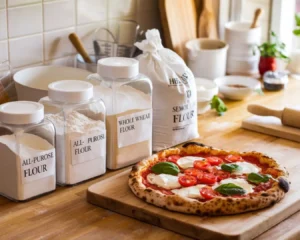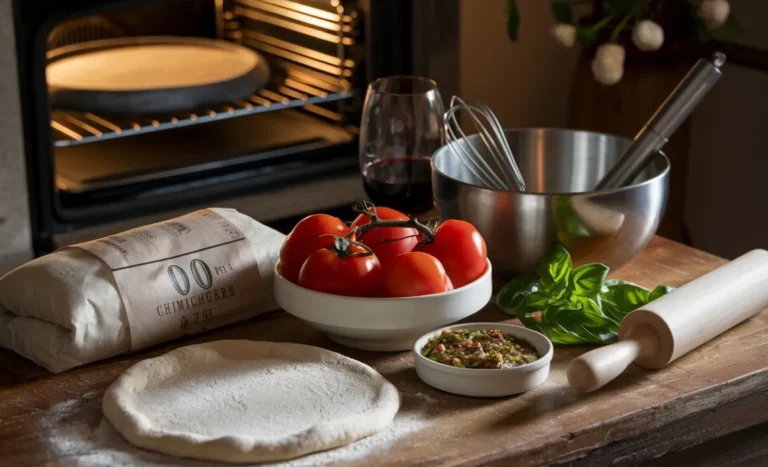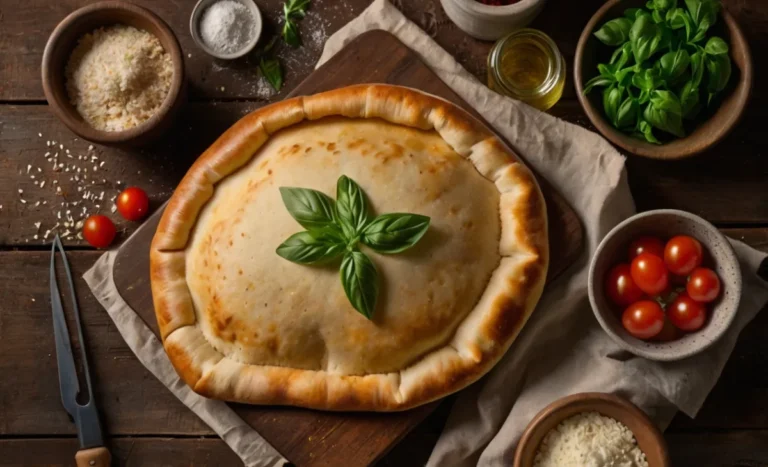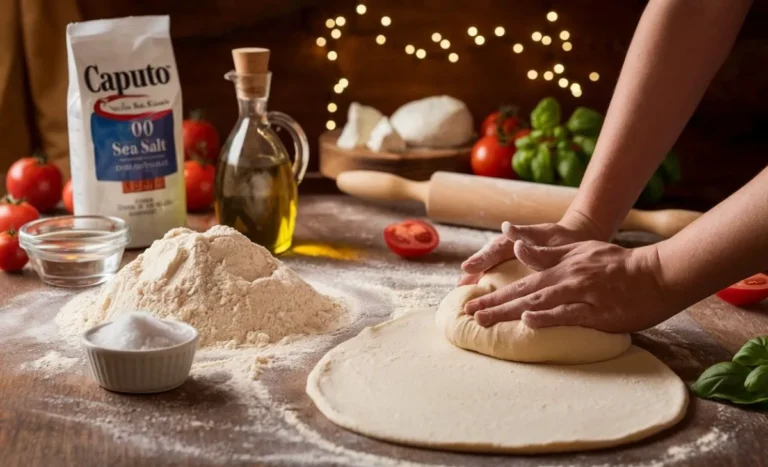Pizza Flour 101: Everything You Need to Know for Crispy and Chewy Crusts
Understanding Pizza Flour: What Makes It Unique
When it comes to crafting the perfect pizza, pizza flour is a crucial ingredient that can significantly impact your crust’s texture and flavor. Unlike regular flour, pizza flour is specifically milled for pizza making. Its unique properties help create the desired crispy and chewy crust that many pizza enthusiasts crave. Understanding the characteristics that make pizza flour special will help you choose the right one for your homemade pizzas and elevate your culinary creations.
One of the main factors that set pizza flour apart is its protein content. Typically, pizza flour has a higher protein level compared to all-purpose flour, which contributes to better gluten formation. Gluten is essential for developing elasticity and structure in the dough. As a result, using pizza flour allows you to stretch and shape your dough without tearing, ensuring a perfect base for your toppings. Additionally, the gluten development helps the crust achieve a desirable chewy texture, making every bite satisfying.
Another key aspect of pizza flour is its grind size. Pizza flour is often milled more finely than standard flour, which improves its ability to absorb water. This fine texture helps create a more cohesive dough that is easier to work with. When mixed, the flour creates a smoother, more elastic dough that can hold up under various toppings. This characteristic is particularly beneficial for those who enjoy loading their pizzas with ingredients, as it prevents sogginess and maintains structural integrity during baking.
Finally, pizza flour often features specific wheat varieties that enhance its baking qualities. Many pizza flours are made from hard wheat, which provides strength and the necessary protein content for great dough. Some brands even produce specialized blends designed for particular styles of pizza, such as Neapolitan or New York-style. By understanding these unique elements of pizza flour, you can make informed choices that lead to better homemade pizzas and satisfy your cravings for crispy and chewy crusts.

Types of Pizza Flour: A Comprehensive Breakdown
When exploring the world of pizza flour, it’s essential to understand the different types available. Each type of pizza flour has unique characteristics that can influence your crust’s texture and flavor. Knowing these distinctions will help you select the best flour for your specific pizza-making needs. Let’s break down the most common types of pizza flour, highlighting their unique qualities and ideal uses.
All-Purpose Flour is one of the most accessible options for home cooks. With a moderate protein content, it can yield decent pizza dough. While it may not produce the same level of chewiness as higher-protein flours, it is versatile and easy to work with. Many home bakers rely on all-purpose flour for convenience, especially when trying out new recipes. However, if you’re aiming for that classic pizza crust texture, you may want to explore other options.
Bread Flour is another popular choice among pizza enthusiasts. With a higher protein content, typically around 12-14%, bread flour creates strong gluten networks, which result in a chewy crust. This flour is excellent for those who enjoy thick, hearty pizzas like Chicago deep-dish. When using bread flour, expect a dough that is elastic and easy to stretch. This makes it an ideal choice for a variety of pizza styles, allowing for the perfect balance between crispiness and chewiness.
For those seeking authenticity, 00 Flour is often the gold standard for Neapolitan-style pizzas. This finely milled Italian flour has a lower protein content than bread flour, usually around 9-11%. Despite its lower protein, 00 flour allows for excellent dough stretchability, resulting in a soft and chewy crust with a slightly crisp exterior. Additionally, its fine texture helps achieve that sought-after leopard spotting when baked at high temperatures. Understanding these types of pizza flour will empower you to experiment with different styles and find the perfect flour for your culinary creations.
Protein Content: The Key to Perfect Crusts
When it comes to making the perfect pizza, pizza flour plays a crucial role, especially regarding protein content. The protein level in flour directly influences the gluten development during kneading, which affects the dough’s structure and texture. Understanding how protein content impacts your pizza crust can help you choose the right flour for your baking needs. This knowledge will lead to the crispy and chewy crust that every pizza lover craves.
Flours with higher protein content, such as bread flour, typically range from 12% to 14%. This higher protein level promotes stronger gluten formation, resulting in a more elastic dough. As you knead the dough, the gluten strands develop, allowing it to stretch without tearing. This elasticity is essential for creating a well-formed pizza base that can hold a variety of toppings without becoming soggy. Therefore, if you desire a hearty crust with a satisfying chew, opting for a flour with a higher protein content is advisable.
On the other hand, lower protein flours, like all-purpose flour or 00 flour, generally contain around 9% to 11% protein. These flours can still produce delicious pizzas, but the texture may differ. While they may yield a softer crust, they often lack the same chewiness that higher-protein flours provide. However, lower protein flours can be beneficial for certain styles of pizza, such as Neapolitan, where a tender, airy crust is desired. Understanding the trade-offs between protein levels will help you select the best flour for your pizza style.
Finally, it’s important to note that not all flours with the same protein content behave the same way. Factors like milling process and wheat variety can also affect gluten strength. Thus, experimenting with different flours can lead to discovering unique textures and flavors in your pizza crust. By focusing on protein content, you can create a pizza that not only satisfies your taste buds but also showcases your skills in the kitchen.

How to Choose the Right Pizza Flour for Your Recipe
Choosing the right pizza flour is essential for achieving the perfect crust in your homemade pizzas. With various flour types available, understanding your recipe’s requirements and desired texture is crucial. This knowledge will help you select the ideal flour, ensuring a crispy and chewy crust that delights every pizza lover. Let’s explore the key factors to consider when choosing the right pizza flour for your next culinary adventure.
First, consider the type of pizza you want to make. Different pizza styles require specific flour characteristics. For example, if you’re aiming for a classic Neapolitan pizza, 00 flour is often recommended due to its fine texture and lower protein content. This flour allows for a soft, airy crust that is still slightly chewy. On the other hand, if you prefer a thicker crust, such as Chicago-style pizza, bread flour with a higher protein content is an excellent choice. It provides the strength and elasticity needed for a hearty, satisfying base.
Next, pay attention to protein content. The protein level in flour affects gluten formation, which in turn influences the dough’s elasticity and chewiness. For thinner crust pizzas, you may want to opt for flour with a lower protein content, allowing for a tender, crispy crust. Conversely, if you want a chewier texture, choose a flour with a higher protein level. Understanding these nuances will guide you in selecting the best flour for your specific recipe.
Finally, don’t forget to experiment with specialty flours. Incorporating unique flours like whole wheat or semolina can add interesting flavors and textures to your pizza crust. Whole wheat flour, for example, offers a nuttier taste and more nutrients, while semolina can enhance the crispiness of the crust. By exploring different combinations, you can find the perfect flour that complements your recipe and personal preferences. Making informed choices about your pizza flour will lead to delightful homemade pizzas that impress your family and friends.
Essential Tips for Storing Pizza Flour Properly
Storing pizza flour properly is crucial for maintaining its freshness and quality. Flour can absorb moisture and odors from the environment, affecting its performance in your recipes. Therefore, understanding how to store pizza flour correctly will ensure you achieve crispy and chewy crusts every time you bake. Here are some essential tips to help you store your pizza flour effectively.
First, choose an appropriate container for your flour. Airtight containers are ideal for preserving freshness. Glass or plastic containers with secure lids will protect the flour from moisture and pests. Avoid using paper bags or cardboard boxes, as they do not provide adequate protection. By keeping your pizza flour in an airtight container, you will help maintain its quality for longer periods.
Next, store your pizza flour in a cool, dry place. Heat and humidity can negatively impact the flour, leading to a decline in quality. A pantry or cupboard away from direct sunlight and heat sources is an excellent choice. Additionally, some bakers prefer to refrigerate or freeze their flour, especially if they buy in bulk. This method can extend its shelf life significantly, allowing you to use it for your pizza-making needs over time.
It’s also important to check the expiration date on your pizza flour packaging. Flour can lose its potency over time, especially if not stored correctly. By regularly monitoring your flour’s freshness, you can ensure you are using the best quality product for your recipes. If you notice any off smells, discoloration, or signs of pests, it’s best to discard the flour. Following these storage tips will help you maintain the integrity of your pizza flour, ensuring delicious, high-quality crusts every time you bake.
Experimenting with Specialty Flours for Unique Pizzas
Experimenting with specialty pizza flour can open up a world of unique flavors and textures for your homemade pizzas. While traditional flours like all-purpose and bread flour are popular choices, using specialty flours can elevate your pizza-making experience. These unique options can provide different tastes and enhance the overall quality of your crust. Let’s explore some specialty flours and how they can transform your pizzas.
One exciting option is whole wheat flour. This flour is made from the entire grain, which includes the bran, germ, and endosperm. As a result, it offers a nuttier flavor and higher nutritional content compared to white flour. Using whole wheat flour in your pizza dough can create a hearty crust that pairs well with robust toppings. To achieve the best results, consider blending whole wheat flour with all-purpose flour for a balanced texture. This combination allows you to enjoy the benefits of whole wheat without sacrificing the desired chewiness of your crust.
Another specialty flour to consider is semolina flour, which is coarsely ground from durum wheat. Semolina flour adds a delightful texture to your pizza crust and enhances its crispiness. Many chefs use semolina in combination with other flours to create a unique blend. When incorporated into your pizza dough, semolina can help produce that perfect crunch while maintaining a tender interior. Experimenting with different ratios of semolina to other flours will lead to exciting new crust experiences.
Finally, don’t overlook the potential of gluten-free flours. For those with dietary restrictions, gluten-free pizza flours made from ingredients like rice, almond, or chickpeas can create delicious alternatives. While these flours may require specific binding agents or recipes, they can produce satisfying results when combined correctly. By experimenting with specialty flours, you can cater to various dietary needs while creating unique pizzas that everyone can enjoy. Embrace the world of specialty flours and discover the delightful possibilities for your next pizza night.
Troubleshooting Common Issues with Pizza Dough
Troubleshooting common issues with pizza dough is essential for perfecting your homemade pizzas. Using the right pizza flour and techniques can greatly impact the final product, but sometimes, unexpected problems arise. Whether your dough is too sticky, doesn’t rise, or tears easily, understanding how to address these issues can lead to consistently delicious crusts. Here are some common problems with pizza dough and how to fix them.

Common Dough Issues and Solutions
- Dough Too Sticky
- Ingredients:
- 3 cups pizza flour
- 1 cup warm water
- 1 packet (2 1/4 tsp) active dry yeast
- 1 tsp sugar
- 1 tsp salt
- 1 tbsp olive oil
- Solution:
- Start by adding additional flour, one tablespoon at a time, while kneading. This will help absorb the excess moisture.
- Make sure to knead until the dough becomes smooth and elastic.
- If your environment is particularly humid, consider reducing the amount of water in the recipe next time.
- Ingredients:
- Dough Doesn’t Rise
- Solution:
- Ensure your yeast is active. To check, mix the yeast and sugar in warm water. If it doesn’t foam after 10 minutes, the yeast may be expired.
- Allow the dough to rise in a warm, draft-free area. An oven preheated to 200°F (93°C) for a few minutes can provide a cozy environment for rising.
- Cover the bowl with a damp cloth to maintain moisture while the dough rises.
- Solution:
- Dough Tears Easily
- Solution:
- This issue often arises from not kneading the dough enough. Ensure you knead the dough for at least 8-10 minutes to develop gluten.
- Let the dough rest for about 10 minutes before stretching. This allows the gluten to relax, making it easier to shape.
- If you’re using whole wheat flour, consider combining it with all-purpose flour for better elasticity.
- Solution:
- Dough Is Too Tough
- Solution:
- If your crust is tough, you may have over-kneaded it. Knead just until the dough is smooth and elastic.
- Consider using a flour with lower protein content, such as 00 flour, which can create a softer texture.
- Allow your dough to rest longer before stretching. This resting period can help soften the gluten structure.
- Solution:
Conclusion
With these troubleshooting tips, you can overcome common pizza dough issues and make adjustments for a perfect crust. Remember that using the right pizza flour is key to achieving crispy and chewy results. Don’t hesitate to experiment and refine your techniques until you find the ideal method that works for you. Happy pizza-making!
The Ultimate Guide to Choosing the Best Pizza Flour for Perfect Homemade Pizzas







